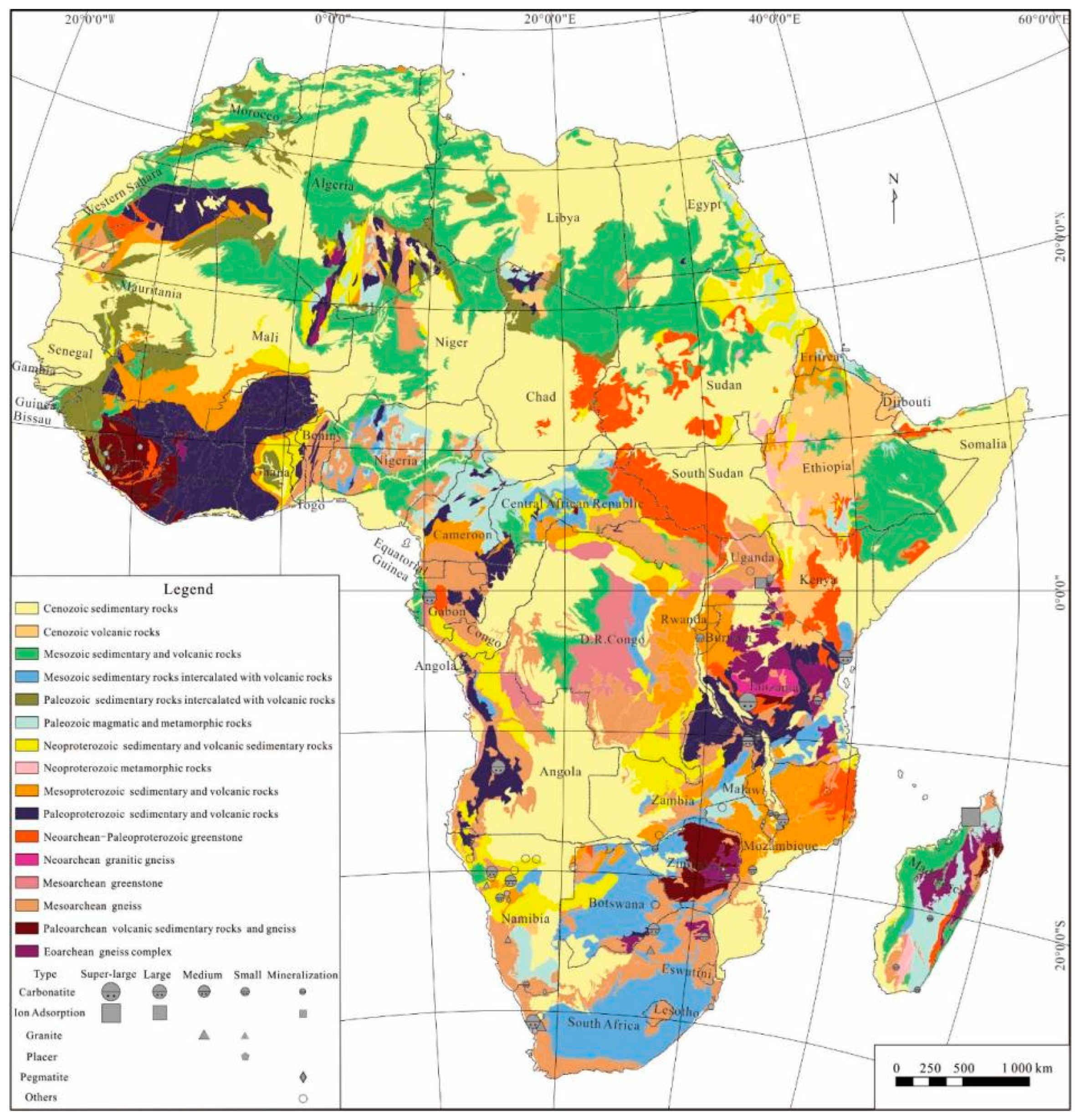A Review of Rare Earth Elements Resources in Africa
Abstract
1. Introduction
2. Distribution of REE Deposits and Resources in Africa
2.1. REE Deposits
2.2. REE Resources
3. REE Deposits in Africa
3.1. Deposit Types
3.2. Mineralization Ages
3.3. Typical Deposits
3.3.1. Ngualla REE Deposit
3.3.2. Phalaborwa (Palabora) REE Deposit
3.3.3. Lofdal REE Deposit
3.3.4. Ambohimirahavavy REE Deposit
3.3.5. Steenkampskraal REE Deposit
4. Exploration Investment in African REE Deposits over the Past Years
5. Future Trends in REE Resource Prices
6. Conclusions
- African REE deposits are primarily distributed within tectonic belts of varying ages along the margins of the Kaapvaal, Zimbabwe, and Tanzania Cratons. These deposits can be classified into eight types: carbonatite, placer, pegmatite, ion-adsorption, granite, metamorphic, sedimentary, and unconformity (spanning a broad range of mineralization ages). Currently, carbonatite and ion-adsorption-type deposits are the primary targets for exploration and development.
- Africa’s REE resources are concentrated in 12 countries: Tanzania, Angola, Kenya, Gabon, South Africa, Madagascar, Malawi, Namibia, Uganda, Zambia, Mozambique, and Burundi. The reserves and advanced resources of REO are 195.6 × 104 t and 1014.4 × 104 t, respectively. Tanzania leads with REO reserves of 88.7 × 104 t and advanced resources of 333.9 × 104 t, ranking first in Africa
- Exploration investment in African deposits peaked in 2012, followed by a steady decline, until it reached its lowest point in 2017. Since 2018, investments have rebounded sharply. In 2024, exploration spending reached $34.8 million, marking a 112.2% year-on-year increase—a significant surge.
- Looking ahead, as international REE deposits commence production, LREEs will face heightened global competition, likely leading to price stabilization or a slight decline in price. In contrast, HREEs, influenced by China’s domestic reserve policies, are expected to see gradually rising prices.
Author Contributions
Funding
Data Availability Statement
Acknowledgments
Conflicts of Interest
References
- Ren, J.P.; Zhang, H.; Gu, A.L.; Sun, K.; Li, J.W.; Hu, P.; Sun, H.W.; Lu, Y.G.; Wu, X.Y.; Zhou, Z.M.; et al. Research progress of rare earth element resources in Africa. Geol. Bull. China 2023, 42, 1241–1257, (In Chinese with English abstract). [Google Scholar]
- Goodenough, K.M.; Wall, F.; Merriman, D. The rare earth elements: Demand, global resources, and challenges for resourcing future generations. Nat. Resour. Res. 2017, 27, 201–216. [Google Scholar] [CrossRef]
- Krishnamurthy, N.; Gupta, C.K. Extractive Metallurgy of Rare Earths, 2nd ed.; CRC Press: New York, NY, USA, 2015; pp. 1–84. [Google Scholar]
- USGS. Mineral Commodity Summaries 2025: Mineral Commodity Summaries; U.S. Geological Survey: Reston, VA, USA, 2025. [Google Scholar] [CrossRef]
- Ministry of Industry and Information Technology and Ministry of Natural Resources. The Third Batch of Total Control Indicators for Rare Earth Mining, Smelting and Separation in 2023. 2023. Available online: https://wap.miit.gov.cn/jgsj/ycls/wjfb/art/2023/art_5f2971532a5d4372b655d43c7de95864.html (accessed on 22 May 2025).
- Ren, J.P.; Hu, P.; Wang, J.; Wang, J.X.; Zhang, H.; Liu, J.T.; Liu, X.Y.; Zeng, G.P.; Sun, K.; Jiang, J.S.; et al. Mining development status of Africa. Acta Geol. Sin. 2021, 95, 945–961, (In Chinese with English abstract). [Google Scholar]
- S&P Global Market Intelligence. Commodities, Countries, Screener (EB/OL). (2025-3-15). 2025. Available online: https://www.capitaliq.spglobal.com/web/client?auth=inherit#industry/commodityProfile (accessed on 16 May 2025).
- Wall, F.; Rollat, A.; Pell, R.S. Responsible sourcing of critical metals. Elements 2017, 13, 313–318. [Google Scholar] [CrossRef]
- Harmer, R.E.; Gittins, J. The origin of dolomitic carbonatites: Field and experimental constraints. J. Afr. Earth Sci. 1997, 25, 5–28. [Google Scholar] [CrossRef]
- Madugalla, T.; Pitawala, H.; Karunaratne, D. Use of carbonatites in the production of precipitated calcium carbonate: A case study from Eppawala, Sri Lanka. Nat. Resour. Res. 2014, 23, 217–229. [Google Scholar] [CrossRef]
- Kanazawa, Y.; Kamitani, M. Rare earth minerals and resources in the world. J. Alloys Compd. 2006, 408, 1339–1343. [Google Scholar] [CrossRef]
- Kynicky, J.; Smith, M.P.; Xu, C. Diversity of rare earth deposits: The key example of China. Elements 2012, 8, 361–367. [Google Scholar] [CrossRef]
- Bodeving, S.; Williams-Jones, A.E.; Swinden, S. Carbonate–silicate melt immiscibility, REE mineralising fluids, and the evolution of the Lofdal Intrusive Suite, Namibia. Lithos 2017, 268, 383–398. [Google Scholar] [CrossRef]
- Broom-Fendley, S.; Brady, A.E.; Horstwood, M.S.A.; Woolley, A.R.; Mtegha, J.; Wall, F.; Dawes, W.; Gunn, G. Geology, geochemistry and geochronology of the Songwe Hill carbonatite, Malawi. J. Afr. Earth Sci. 2017, 134, 10–23. [Google Scholar] [CrossRef]
- Buyse, F.; Dewaele, S.; Decrée, S.; Mees, F. Mineralogical and geochemical study of the rare earth element mineralization at Gakara (Burundi). Ore Geol. Rev. 2020, 124, 103659. [Google Scholar] [CrossRef]
- Gu, A.L.; Wang, J.; Ren, J.P.; Zuo, L.B.; Sun, H.W.; Xing, S.; Liu, Z.J.; Zhang, J.D.; Chikambwe, E.; Kasumba, E. Petrogenesis of the Paleoproterozoic granitoids in Kapatu, Northern Zambia: Constrains by geochemistry, zircon U-Pb chronology and Hf isotope. Acta Geol. Sin. 2021, 95, 999–1018, (In Chinese with English abstract). [Google Scholar]
- Kasay, G.M.; Bolarinwa, A.T.; Aromolaran, O.K.; Nzolang, C.; Sekeraviti, A.K. Rare earth element deposits and prospects in the Democratic Republic of Congo. Min. Metall. Explor. 2022, 39, 625–642. [Google Scholar] [CrossRef]
- Lehmann, B.; Nakai, S.; Höhndorf, A.; Brinckmann, J.; Dulski, P.; Hein, U.F.; Masuda, A. REE mineralization at Gakara, Burundi: Evidence for anomalous upper mantle in the western Rift Valley. Geochim. Cosmochim. Acta 1994, 58, 985–992. [Google Scholar] [CrossRef]
- Witt, W.K.; Hammond, D.P.; Hughes, M. Geology of the Ngualla carbonatite complex, Tanzania, and origin of the Weathered Bastnaesite Zone REE ore. Ore Geol. Rev. 2019, 105, 28–54. [Google Scholar] [CrossRef]
- Wu, F.Y.; Yang, Y.H.; Li, Q.L.; Mitchell, R.H.; Dawson, J.B.; Brandl, G.; Yuhara, M. In situ determination of U–Pb ages and Sr–Nd–Hf isotopic constraints on the petrogenesis of the Phalaborwa carbonatite Complex, South Africa. Lithos 2011, 127, 309–322. [Google Scholar] [CrossRef]
- Tulibonywa, T.; Manya, S.; Maboko, M.A.H. Palaeoproterozoic volcanism and granitic magmatism in the Ngualla area of the Ubendian Belt, SW Tanzania: Constraints from SHRIMP U–Pb zircon ages, and Sm–Nd isotope systematic. Precambrian Res. 2015, 256, 120–130. [Google Scholar] [CrossRef]
- Hawkesworth, C.J.; Gledhill, A.R.; Roddick, J.C.; Miller, R.M.; Kröner, A. Rb–Sr and 40Ar/39Ar studies bearing on models for the thermal evolution of the Damara Belt, Namibia. In Evolution of the Damara Orogen of South West Africa/Namibia. Geol. Soc. S. Afr. 1983, 11, 323–338. [Google Scholar]
- Jung, S.; Hoffer, E.; Hoernes, S. Neo-Proterozoic rift-related syenites (northern Damara Belt, Namibia): Geochemical and Nd–Sr–Pb–O isotope constraints for mantle sources and petrogenesis. Lithos 2007, 96, 415–435. [Google Scholar] [CrossRef]
- Wall, F.; Niku-Paalova, V.N.; Storey, C.; Müller, A.; Jeffries, T. Xenotime-(Y) from carbonatite dykes at Lofdal, Namibia: Unusually low LREE: HREE ratio in carbonatite, and the first dating of xenotime overgrowths on zircon. Can. Mineral. 2008, 46, 861–877. [Google Scholar] [CrossRef]
- Snelling, N.J. Age determinations on three African carbonatites. Nature 1965, 205, 492. [Google Scholar] [CrossRef]
- Zambezi, P.; Voncken, J.H.L.; Hale, M.; Touret, J.L.R. Bastnäsite-(Ce) at the Nkombwa Hill carbonatite complex, Isoka District, northeast Zambia. Mineral. Petrol. 1997, 59, 239–250. [Google Scholar] [CrossRef]
- Nakai, S.; Masuda, A.; Lehmann, B. La-Ba dating of bastnaesite. Am. Mineral. 1988, 73, 1111–1113. [Google Scholar] [CrossRef]
- Smithies, R.H.; Marsh, J.S. The Marinkas Quellen Carbonatite Complex, southern Namibia: Carbonatite magmatism with an uncontaminated depleted mantle signature in a continental setting. Chem. Geol. 1998, 148, 201–212. [Google Scholar] [CrossRef]
- Kramm, U.; Körner, T.; Kittel, M.; Baier, H.; Sindern, S. Triassic emplacement age of the Kalkfeld complex, NW Namibia: Implications for carbonatite magmatism and its relationship to the Tristan Plume. Int. J. Earth Sci. 2017, 106, 2797–2813. [Google Scholar] [CrossRef]
- Wu, X.Y.; Liu, X.Y.; Ren, J.P.; He, S.F.; Sun, K.; Sun, H.W. Recent progress of the geochemical and petrogenesis research of the Panda Hill Carbonatite, Tanzania. Geol. Surv. Res. 2019, 42, 86–95, (In Chinese with English abstract). [Google Scholar]
- Knoper, M.W. The mesoproterozoic Steenkampskraal rare-earth element deposit in Namaqualand, South Africa. In Proceedings of the 2010 GSA, Denver Annual Meeting, Denver, CO, USA, 31 October–3 November 2010; pp. 132–134. [Google Scholar]
- Siedner, G.; Miller, J.A. K-Ar age determination on basaltic rocks from South West Africa and their bearing on continental drift. Earth Planet. Sci. Lett. 1968, 4, 451–458. [Google Scholar] [CrossRef]
- Hu, P.; Ren, J.P.; Xiang, P.; Gu, A.L.; Wang, J.X.; Wang, J.; Wu, D.T.; Xiang, W.S.; Sun, K.; Zhao, K.; et al. Division of tectonic units in African continent. Geol. Bull. China 2022, 41, 1–18, (In Chinese with English abstract). [Google Scholar]
- Gu, A.L.; Ren, J.P.; Wang, J.; Peng, J.; Zuo, L.B.; Sun, H.W.; Liu, X.Y.; Sun, K.; Gong, P.H.; Tang, W.L. Analysis of mineral resources and the mining investment environment in Tanzania. Geol. Bull. China 2023, 42, 1291–1301, (In Chinese with English abstract). [Google Scholar]
- Wang, J.; Liu, X.Y.; Ren, J.P.; Sun, K.; Gong, P.H.; He, F.Q. Precambrian mineralization in Tanzania. North China Geol. 2022, 45, 101–110, (In Chinese with English abstract). [Google Scholar]
- Shenghe Resources Holding Co., Ltd. (2022) (EB/OL). 2022. Available online: http://data.eastmoney.com/notices/detail/600392/AN202210191579269359.html (accessed on 2 May 2025).
- Cahen, L.; Snelling, N.J. The Geochronology of Equatorial Africa; North Holland: Amsterdam, The Netherlands, 1966; p. 195. [Google Scholar]
- De Waele, B.; Johnson, S.P.; Pisarevsky, S.A. Palaeoproterozoic to Neoprorerozoic growth and evolution of the eastern Congo Ccaton: Its role in the Rodinia puzzle. Precambrian Res. 2008, 180, 127–141. [Google Scholar] [CrossRef]
- Reischmann, T. Precise U/Pb age determination with baddeleyite (ZrO2), a case study from the Phalaborwa igneous complex, South Africa. S. Afr. J. Geol. 1995, 98, 1–4. [Google Scholar]
- Groves, D.I.; Vielreicher, N.M. The Phalabowra (Palabora) carbonatite-hosted magnetite-copper sulfide deposit, South Africa:An end-member of the iron-oxide copper-gold-rare earth element deposit groups? Miner. Depos. 2001, 36, 189–194. [Google Scholar] [CrossRef]
- Emsbo, P.; Mc Laughlin, P.I.; Breit, G.N.; du Bray, E.A.; Koenig, A.E. Rare earth elements in sedimentary phosphate deposits: Solution to the global REE crisis? Gondwana Res. 2015, 27, 776–785. [Google Scholar] [CrossRef]
- Ihlen, P.M.; Schiellerup, H.; Gautneb, H.; Skår, Ø. Characterization of apatite resources in Norway and their REE potential-a review. Ore Geol. Rev. 2014, 58, 126–147. [Google Scholar] [CrossRef]
- Decrée, S.; Cawthorn, G.; Deloule, E.; Mercadier, J.; Frimmel, H.; Baele, J.-M. Unravelling the processes controlling apatite formation in the Phalaborwa Complex (South Africa) based on combined cathodoluminescence, LA-ICPMS and in-situ O and Sr isotope analyses. Contrib. Mineral. Petrol. 2020, 175, 34. [Google Scholar] [CrossRef]
- Dawson, J.B.; Hinton, R.W. Trace-element content and partitioning in calcite, dolomite and apatite in carbonatite, Phalaborwa, South Africa. Mineral. Mag. 2003, 67, 921–930. [Google Scholar] [CrossRef]
- Hornig-Kjaarsgaard, I. Rare earth elements insöviticc arbonatites and their mineral phases. J. Petrol. 1998, 39, 2105–2121. [Google Scholar] [CrossRef]
- Zirner, A.L.; Marks, M.A.; Wenzel, T.; Jacob, D.E.; Markl, G. Rare earth elements in apatite as a monitor of magmatic and metasomatic processes: The Ilímaussaq complex, South Greenland. Lithos 2015, 228, 12–22. [Google Scholar] [CrossRef]
- Milani, L.; Bolhar, R.; Frei, D.; Harlov, D.E.; Samuel, V.O. Light rare earth element systematics as a tool for investigating the petrogenesis of phoscorite-carbonatite associations, as exemplified by the Phalaborwa Complex, South Africa. Min. Depos. 2017, 52, 1105–1125. [Google Scholar] [CrossRef]
- Broom-Fendley, S.; Heaton, T.; Wall, F.; Gunn, G. Tracing the fluid source of heavy REE mineralisation in carbonatites using a novel method of oxygen-isotope analysis in apatite: The example of Songwe Hill, Malawi. Chem. Geol. 2016, 440, 275–287. [Google Scholar] [CrossRef]
- Giebel, R.J.; Gauert, C.D.; Marks, M.A.; Costin, G.; Markl, G. Multistage formation of REE minerals in the Palabora Carbonatite Complex, South Africa. Am. Mineral. 2017, 102, 1218–1233. [Google Scholar] [CrossRef]
- Vartiainen, H.; Paarma, H. Geological characteristics of the Sokli Carbonatite Complex, Finland. Econ. Geol. 1979, 74, 1296–1306. [Google Scholar] [CrossRef]
- Walter, A.V.; Nahon, D.; Flicoteaux, R.; Girard, J.P.; Melf, A. Behaviour of major and trace elements and fractionation of REE under tropical weathering of a typical apatite-rich carbonatite from Brazil. Earth Planet. Sci. Lett. 1995, 136, 591–602. [Google Scholar] [CrossRef]
- Gómez-Arias, A.; Yesares, L.; Díaz, J.; Caraballo, M.A.; Maleke, M.; Sáez, R.; Heerden, E.; Vermeulen, D.; Nieto, J.M.; Castillo, J. Mine waste from carbonatite deposits as potential rare earth resource: Insight into the Phalaborwa (Palabora) Complex. J. Geochem. Explor. 2022, 232, 106884. [Google Scholar] [CrossRef]
- Miller, R.M. Neoproterozoic and early Paleozoic rocks of the Damara Orogen. In The Geology of Namibia; Miller, R.M., Ed.; Ministry of Mines and Energy, Geological Survey: Windhoek, Namibia, 2008; pp. 13-1–114-1. [Google Scholar]
- Sitnikova, M.A.; Cabo, V.D.; Wall, F.; Goldmann, S. Burbankite and pseudomorphs from the Main Intrusion calcite carbonatite, Lofdal, Namibia: Association, mineral composition, Raman spectroscopy. Mineral. Mag. 2021, 85, 496–513. [Google Scholar] [CrossRef]
- Bao, Z.; Zhao, Z. Geochemistry of mineralization with exchangeable REY in the weathering crusts of granitic rocks in South China. Ore Geol. Rev. 2008, 33, 519–535. [Google Scholar] [CrossRef]
- Li, Y.H.M.; Zhao, W.W.; Zhou, M.F. Nature of parent rocks, mineralization styles and ore genesis of regolith-hosted REE deposits in South China: An integrated genetic model. J. Asian Earth Sci. 2017, 148, 65–95. [Google Scholar] [CrossRef]
- Sanematsu, K.; Watanabe, Y. Characteristics and genesis of ion adsorption-type rare earth element deposits. In Rare Earth and Critical Elements in Ore Deposits; Verplanck, P.L., Hitzman, M.W., Eds.; Society of Economic Geologists: Littleton, CO, USA, 2016. [Google Scholar] [CrossRef]
- Estrade, G.; Marquis, E.; Smith, M.; Goodenough, K.; Nason, P. REE concentration processes in ion adsorption deposits: Evidence from the Ambohimirahavavy alkaline complex in Madagascar. Ore Geol. Rev. 2019, 112, 103027. [Google Scholar] [CrossRef]
- Cucciniello, C.; Tucker, R.D.; Jourdan, F.; Melluso, L.; Morra, V. The age and petrogenesis of alkaline magmatism in the Ampasindava Peninsula and Nosy Be archipelago, northern Madagascar. Mineral. Petrol. 2016, 110, 309–331. [Google Scholar] [CrossRef]
- Melluso, L.; Morra, V.; Brotzu, P.; Franciosi, L.; Grifa, C.; Lustrino, M.; Morbidelli, P.; Riziky, H.; Vincent, M. The Cenozoic alkaline magmatism in central-northern Madagascar: A brief overview. Period. Di Mineral. 2007, 76, 169–180. [Google Scholar]
- Ganzeev, A.A.; Grechishchev, O.K. A new genetic type of rare-metal alkali granites of Madagascar. Russ. Geol. Geophys. 2003, 44, 539–553. [Google Scholar]
- Estrade, G.; Salvi, S.; Béziat, D. Crystallisation and destabilisation of eudialyte group minerals in peralkaline granite and pegmatite: A case study from the Ambohimirahavavy complex, Madagascar. Mineral. Mag. 2018, 82, 375–399. [Google Scholar] [CrossRef]
- Steenkampskraal Rare Earths Mine Website (2025) (EB/OL). 2025. Available online: https://www.steenkampskraal.com (accessed on 22 June 2025).
- Read, D.; Andreoli, M.A.G.; Knoper, M.; Williams, T.; Jarvis, N. The degradation of monazite: Implications for the mobility of rare-earth and actinide elements during low-temperature alteration. Eur. J. Mineral. 2002, 14, 487–498. [Google Scholar] [CrossRef]
- Andreoli, M.A.G.; Hart, R.J.; Ashwal, L.D.; Coetzee, H. Correlations between U, Th content and metamorphic grade in the Western Namaqualand Belt, South Africa, with implications for radioactive heating of the crust. J. Petrol. 2006, 47, 1095–1118. [Google Scholar] [CrossRef]
- Basson, I.J.; Muntingh, A.; Jellicoe, B.C.; Anthonissen, C.J. Structural interpretation of the Steenkampskraal monazite deposit, Western Cape, South Africa. J. Afr. Earth Sci. 2016, 121, 301–315. [Google Scholar] [CrossRef]
- Argus Media Website. 2025. (EB/OL). Available online: https://www.argusmedia.com/metals-platform/dashboards/index/4 (accessed on 2 July 2025).


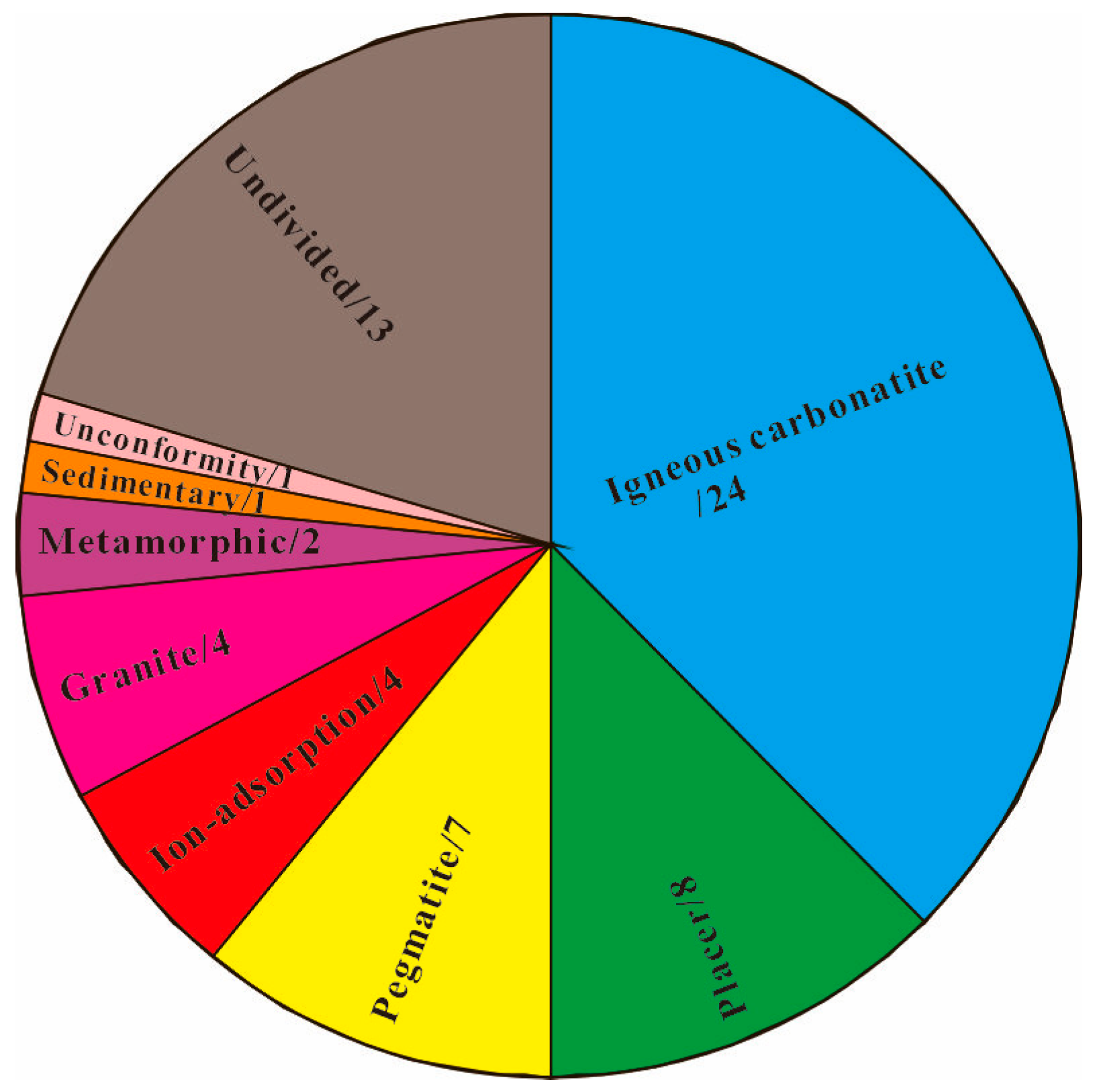

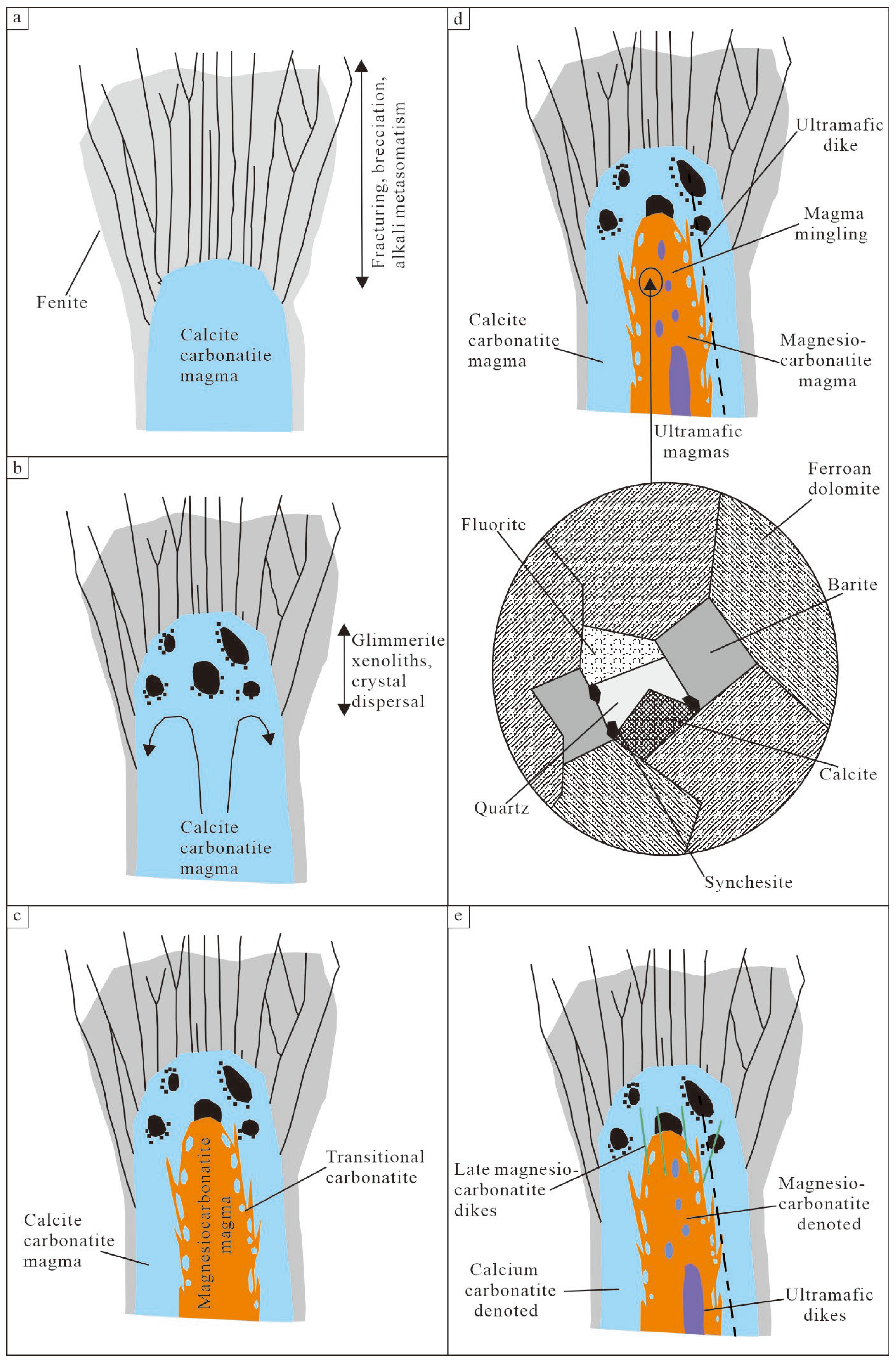
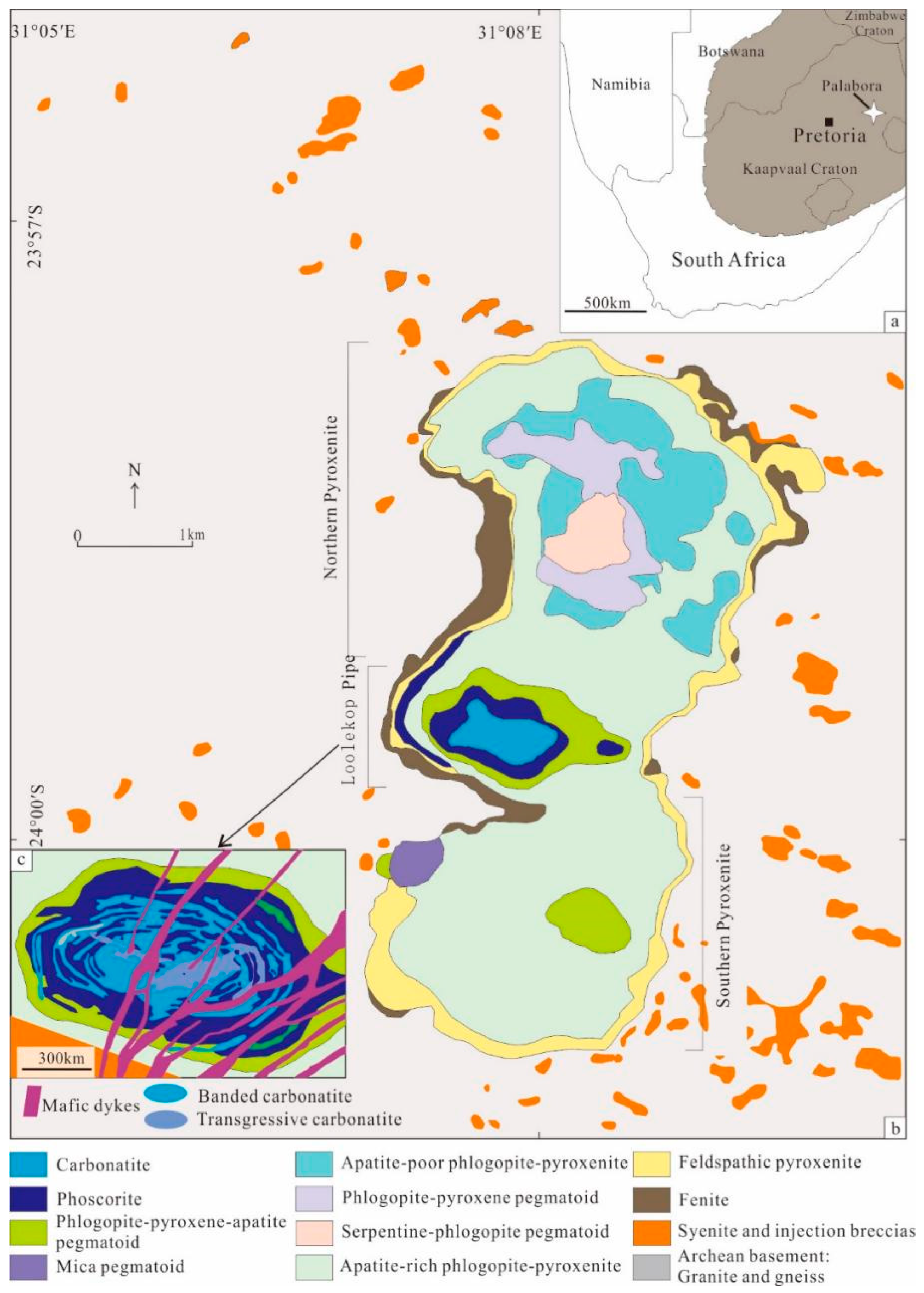
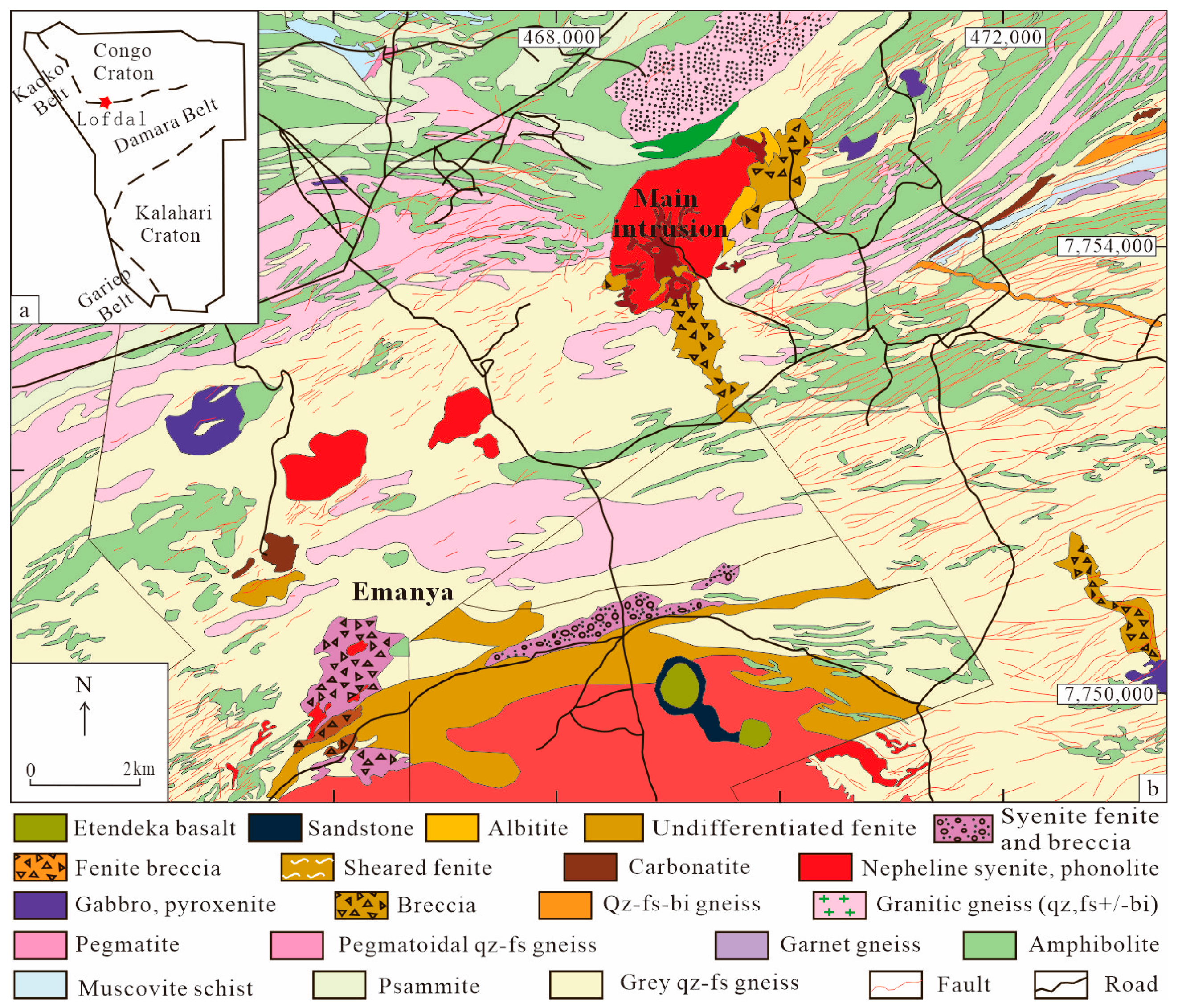
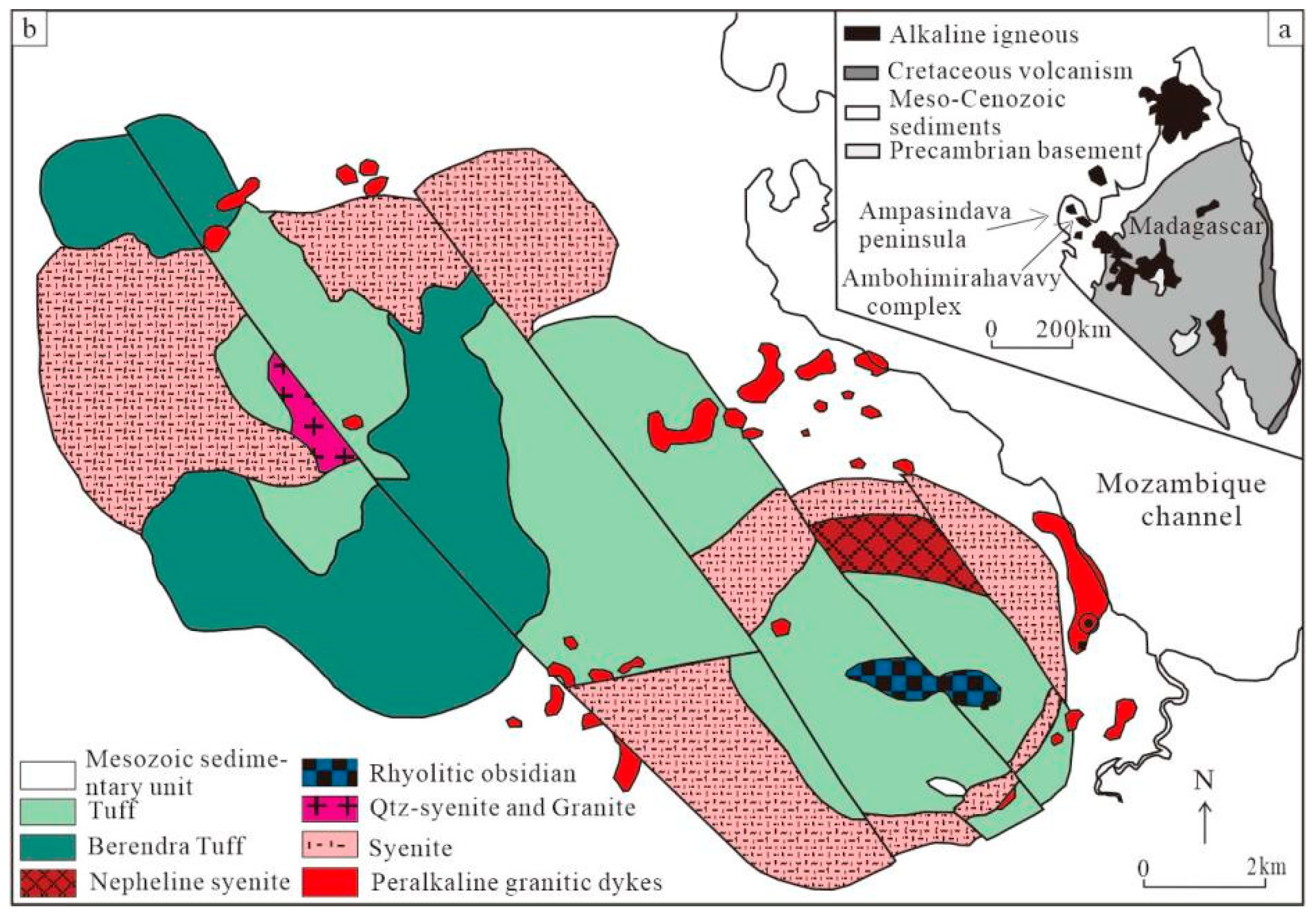
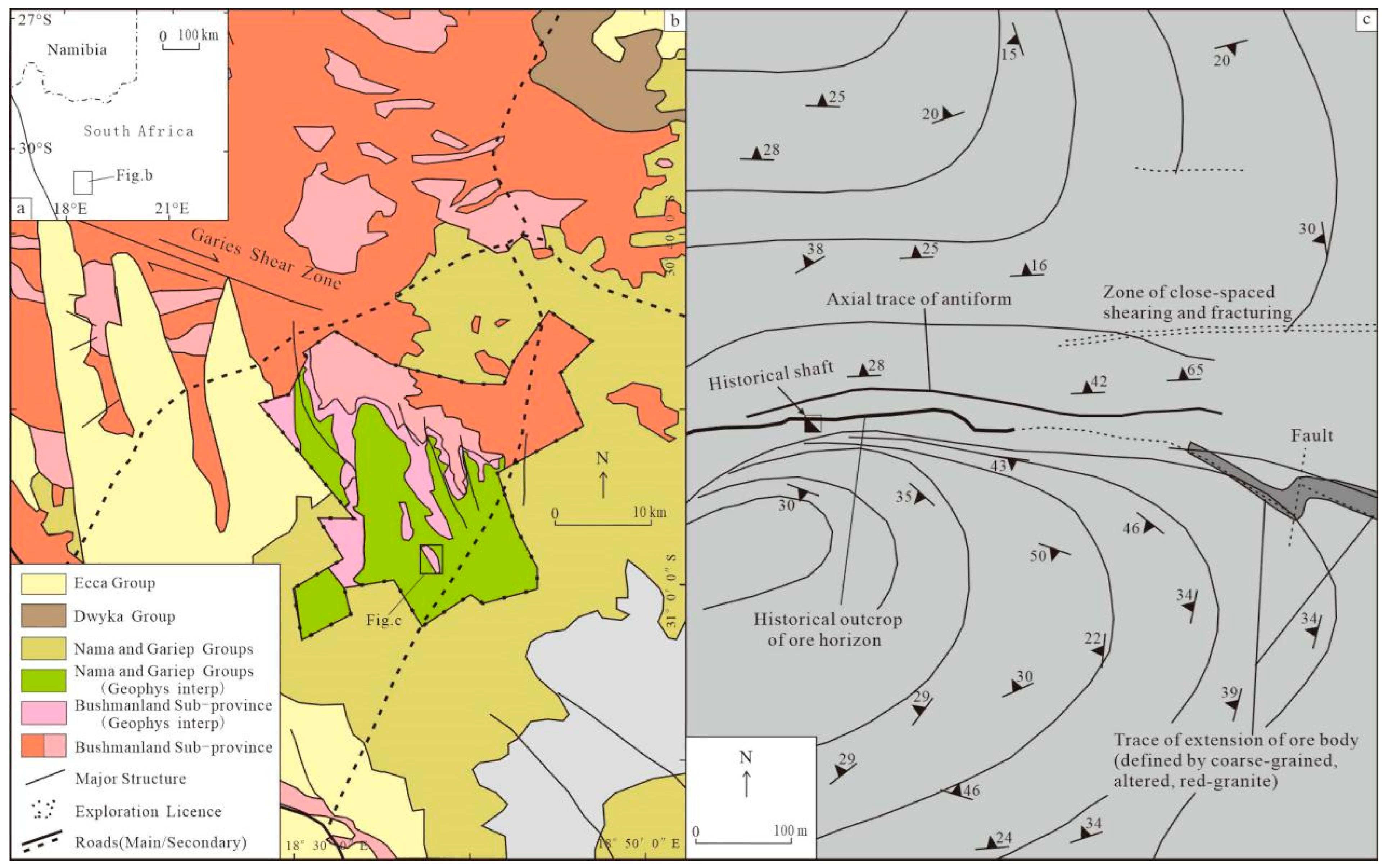

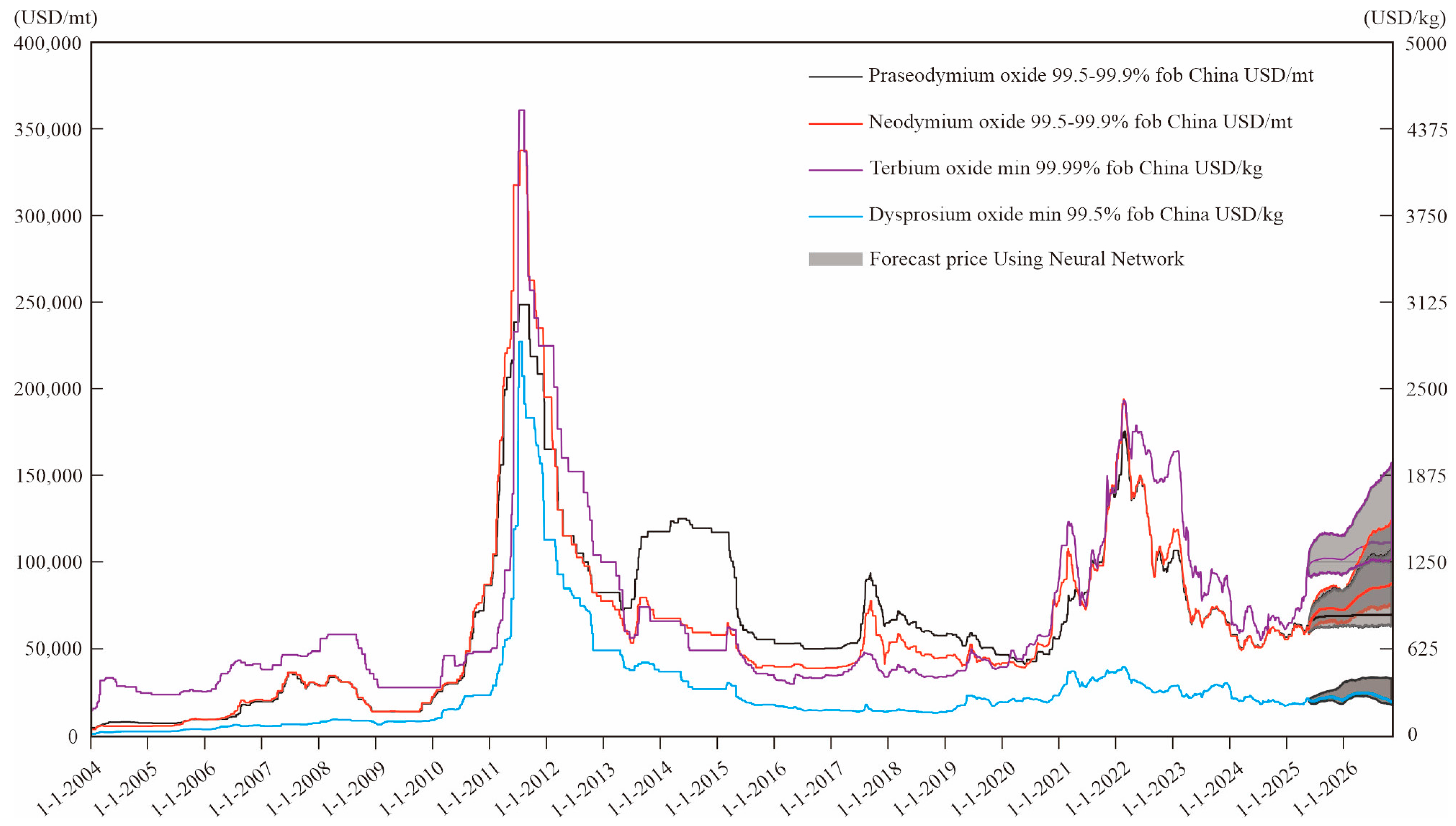
| Country | Mine Production * (TREO; t) | Reserves (REO; ×104 t) | |
|---|---|---|---|
| 2023 | 2024 | ||
| China | 255,000 | 270,000 | 4400 |
| Burma | 43,000 | 31,000 | —— |
| United States | 41,600 | 45,000 | 190 |
| Australia | 16,000 | 13,000 | 570 |
| Nigeria | 7200 | 13,000 | —— |
| Thailand | 3600 | 13,000 | 0.45 |
| India | 2900 | 2900 | 690 |
| Russia | 2500 | 2500 | 380 |
| Madagascar | 2100 | 2000 | —— |
| Malaysia | 310 | 130 | —— |
| Vietnam | 300 | 300 | 350 |
| Brazil | 140 | 20 | 2100 |
| Greenland | —— | —— | 150 |
| Tanzania | —— | —— | 89 |
| Canada | —— | —— | 83 |
| South Africa | —— | —— | 86 |
| Other | 1440 | 1100 | —— |
| No. | Deposit | Country | City | Holding Company | Development Stage | Activity Status | High-Grade Resources (Including Reserves; TREO) | Grade (%) | Year of High-Grade Resources |
|---|---|---|---|---|---|---|---|---|---|
| 1 | Ngualla | Tanzania | Songwe | Shenghe Resources Holding Co., Ltd. | Construction Planned | Active | 428 × 104 t (HREE 1%) | 2.49 | 2017 |
| 2 | Mrima Hill | Kenya | Kwale | National Mining Corporation of Kenya | Reserves Development | Under Litigation | 214.3 × 104 t | 2.22 | 2013 |
| 3 | Kangankunde | Malawi | Balaka | Lindian Resources Ltd. | Preproduction | Active | 148 × 104 t (HREE 0.55%) | 2.48 | 2024 |
| 4 | Ozango | Angola | Huambo | Pensana Metals Ltd. | Construction Planned | Active | 65.5 × 104 t (Praseodymium and Neodymium oxide 23 × 104 t) | 3.04 | 2025 |
| 5 | Zandkopsdrift | South Africa | Northern Cape | Frontier Rare Earths Ltd. | Reserves Development | Active | 53.2 × 104 t (HREE 6.6%) | 2.32 | 2013 |
| 6 | Songwe Hill | Malawi | Phalombe | Mkango Resources Ltd. | Feasibility Complete | Active | 29.74 × 104 t (HREE 6.7%) | 1.41 | 2022 |
| 7 | Monte Muambe | Mozambique | Tete | Altona Rare Earths Plc | Prefeas/Scoping | Active | 19.1 × 104 t | 2.38 | 2023 |
| 8 | Ampasindava (Tantalus) | Madagascar | Antsiranana | Harena Resources plc | Reserves Development | Active | 17.7 × 104 t (HREE 37.3%) | 0.09 | 2014 |
| 9 | Phalaborwa | South Africa | Limpopo | Rainbow Rare Earths Limited | Feasibility Started | Active | 13.7 × 104 t | 0.44 | 2024 |
| 10 | Steenkampskraal | South Africa | Western Cape | Steenkampskraal Monazite Mine Proprietary Ltd. | Feasibility Complete | Active | 8.7 × 104 t (HREE 8.0%) | 8.68 | 2014 |
| 11 | Lofdal | Namibia | Kunene | Namibia Critical Metals Inc. | General Exploration | Active | 7.6 × 104 t (HREE 75.2%) | — | 2024 |
| 12 | Nkombwa Hill | Zambia | Muchinga | Gathoni Muchai Invts Ltd. | Reserves Development | Active | 5.2 × 104 t | 1.59 | 2016 |
| 13 | Gakara | Burundi | Bujumbura Rural | Rainbow Rare Earths Ltd. | Operating | Care And Maintenance | 3.3 × 104 t | 2.80 | 2018 |
| No. | Name | Country | Deposit Type | Main Minerals | Metallogenic Ages (Ma) | Methods | Tectonic Setting | References |
|---|---|---|---|---|---|---|---|---|
| 1 | Phalaborwa | South Africa | Carbonatite | Monazite, Apatite and Calcite | 2060 Ma | Zircon U-Pb LA-ICP-MS | Kaapvaal Craton | [20] |
| 2 | Ngualla | Tanzania | Carbonatite | Parisite, Monazite and Apatite | 1943–1871 Ma | Zircon U-Pb SHRIMP | Ubendian Belt | [21] |
| 3 | Lofdal | Namibia | Carbonatite | Bastnasite, Monazite and Xenotime | ~760 Ma | Nepheline-syenite Rb-Sr, Sphene and Zircon U–Pb LA–ICP–MS | Damara Belt | [22,23,24] |
| 4 | Nkombwa Hill | Zambia | Carbonatite | Bastnasite and Monazite | 680 Ma | Phlogopite Rb-Sr | Irumide Belt | [25,26] |
| 5 | Gakara | Burundi | Carbonatite | Bastnasite and Monazite | 602–587 Ma | Bastnasite 138La-138Ba, Bastnasite and Monazite LA–ICP–MS | Kibaran Belt | [27] |
| 6 | Marinkas | Namibia | Carbonatite | Apatite | 567–520 Ma | Muscovite K-Ar and Alkaline granite (No note method) | Kuboos-Bremen Igneous Province | [28] |
| 7 | Kalkfeld | Namibia | Carbonatite | Apatite | 242 Ma | Nepheline-syenite Whole-rock Rb-Sr | Damara Belt | [29] |
| 8 | Songwe Hill | Malawi | Carbonatite | Apatite and Parisite | 133 Ma | Zircon U-Pb LA-ICP-MS | Chilwa Alkaline Province | [14] |
| 9 | Kangankunde | Malawi | Carbonatite | Monazite | 123 Ma | Phlogopite Rb-Sr | Chilwa Alkaline Province | [25] |
| 10 | Panda Hill | Tanzania | Carbonatite | Bastnasite and Apatite | 113 Ma | Phlogopite Rb-Sr | Ubendian Belt | [25,30] |
| 11 | Steenkampskraal | South Africa | Granite | Monazite | 1046 Ma | Zircon SHRIMP U-Pb | Bushmanland Sub-province | [31] |
| 12 | Brandberg | Namibia | Granite | Monazite | 164–123 Ma | Basalt and diabase K-Ar | Damara Belt | [32] |
| Country | 2012 | 2013 | 2014 | 2015 | 2016 | 2017 | 2018 | 2019 | 2020 | 2021 | 2022 | 2023 | 2024 |
|---|---|---|---|---|---|---|---|---|---|---|---|---|---|
| Angola | 30 | 10 | —— | 10 | —— | 60 | 100 | 360 | 230 | 580 | 50 | 20 | 50 |
| Botswana | 10 | —— | —— | —— | —— | —— | —— | —— | —— | —— | 10 | 10 | —— |
| Burundi | —— | —— | —— | —— | —— | 10 | 100 | 100 | 100 | 80 | —— | —— | —— |
| Cameroon | 30 | —— | —— | —— | —— | —— | —— | —— | —— | —— | —— | —— | —— |
| Dem. Rep. Congo | 30 | —— | —— | 30 | —— | —— | —— | —— | —— | —— | —— | —— | —— |
| Gabon | 120 | 100 | 100 | —— | —— | —— | 190 | —— | —— | —— | —— | —— | —— |
| Guinea | 10 | —— | —— | —— | —— | —— | —— | —— | —— | —— | —— | —— | —— |
| Kenya | 290 | —— | —— | —— | —— | —— | 10 | —— | —— | —— | —— | —— | —— |
| Madagascar | —— | —— | —— | —— | —— | —— | —— | 60 | 30 | 50 | |||
| Malawi | 500 | 140 | 150 | 50 | 20 | —— | 250 | —— | 200 | 300 | 470 | 670 | 870 |
| Morocco | —— | —— | —— | 220 | 200 | —— | —— | —— | —— | —— | —— | —— | —— |
| Mozambique | 350 | 240 | 30 | —— | —— | —— | 20 | —— | —— | —— | —— | —— | —— |
| Namibia | 1050 | 810 | 470 | 20 | 80 | 40 | —— | 50 | 20 | 540 | 390 | 430 | 460 |
| Senegal | —— | 100 | 300 | —— | —— | —— | —— | —— | —— | —— | —— | —— | —— |
| South Africa | 2260 | 1140 | 570 | 130 | 130 | 60 | 30 | 20 | 10 | 80 | 60 | 80 | 1250 |
| Tanzania | 1000 | 650 | 90 | 80 | 40 | —— | —— | 50 | —— | —— | —— | —— | 70 |
| Togo | —— | 90 | —— | —— | —— | —— | —— | —— | —— | —— | —— | —— | —— |
| Uganda | —— | —— | —— | —— | —— | —— | —— | —— | 90 | 230 | 600 | 42 | 770 |
| Zambia | 20 | —— | —— | —— | —— | —— | —— | —— | —— | —— | 20 | 10 | 10 |
| Zimbabwe | —— | 10 | 100 | —— | —— | —— | —— | —— | —— | —— | —— | —— | —— |
| Total | 5700 | 3290 | 1810 | 540 | 470 | 170 | 700 | 640 | 680 | 1860 | 1600 | 1640 | 3480 |
Disclaimer/Publisher’s Note: The statements, opinions and data contained in all publications are solely those of the individual author(s) and contributor(s) and not of MDPI and/or the editor(s). MDPI and/or the editor(s) disclaim responsibility for any injury to people or property resulting from any ideas, methods, instructions or products referred to in the content. |
© 2025 by the authors. Licensee MDPI, Basel, Switzerland. This article is an open access article distributed under the terms and conditions of the Creative Commons Attribution (CC BY) license (https://creativecommons.org/licenses/by/4.0/).
Share and Cite
Ren, J.; Gu, A.; Sun, K.; Zhang, H.; Li, J.; Sun, H.; Lu, Y.; Tong, X.; Wu, X.; Zhou, Z. A Review of Rare Earth Elements Resources in Africa. Minerals 2025, 15, 980. https://doi.org/10.3390/min15090980
Ren J, Gu A, Sun K, Zhang H, Li J, Sun H, Lu Y, Tong X, Wu X, Zhou Z. A Review of Rare Earth Elements Resources in Africa. Minerals. 2025; 15(9):980. https://doi.org/10.3390/min15090980
Chicago/Turabian StyleRen, Junping, Alei Gu, Kai Sun, Hang Zhang, Jianwu Li, Hongwei Sun, Yiguan Lu, Xin Tong, Xingyuan Wu, and Zuomin Zhou. 2025. "A Review of Rare Earth Elements Resources in Africa" Minerals 15, no. 9: 980. https://doi.org/10.3390/min15090980
APA StyleRen, J., Gu, A., Sun, K., Zhang, H., Li, J., Sun, H., Lu, Y., Tong, X., Wu, X., & Zhou, Z. (2025). A Review of Rare Earth Elements Resources in Africa. Minerals, 15(9), 980. https://doi.org/10.3390/min15090980




